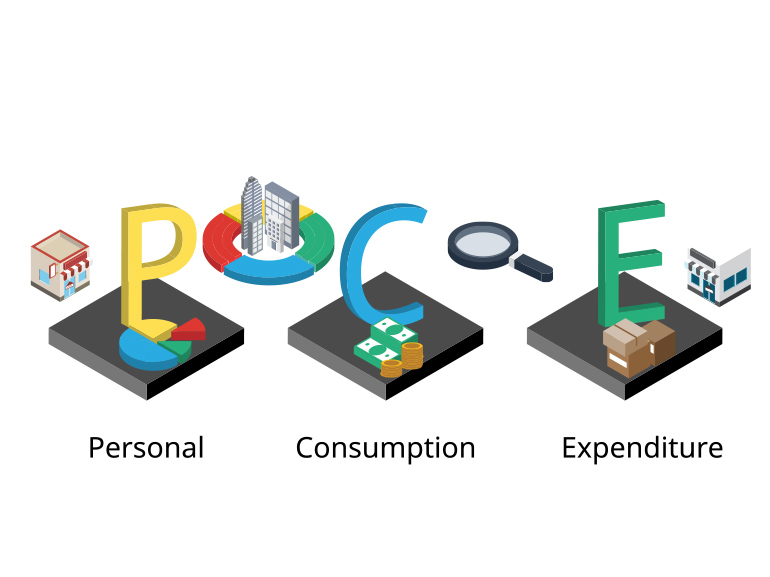PCE: What You Need to Know
Among the variety of economic indicators out there, Personal Consumption Expenditures (PCE) is one of the most important ones.
So what is the PCE exactly and how does it affect the economy? Here’s what you need to know:

What Is the PCE?
The Personal Consumption Expenditures (PCE), which is also referred to as consumer spending is considered by some to be the key inflation gauge used by Central Banks like the Federal Reserve when making interest rate decisions; as such, understanding how it works and its implications is crucial.
What Is the BEA?
The Personal Consumption Expenditures (PCE) metric is published by the Bureau of Economic Analysis (BEA), an entity operating under the Department of Commerce in the United States federal government. This division is tasked with the collection and analysis of economic data.
Why Is PCE Important and What Role Does the PCE Play on the Economy?
Personal Consumption Expenditures play a critical role in measuring the financial outlays individuals allocate for goods and services in the U.S. These sectors hold immense significance for the economy, as they comprise about two-thirds of domestic spending and drive the country's Gross Domestic Product (GDP).
Moreover, PCE figures serve as a crucial metric for analysts and market experts seeking to gauge the potential trajectory of spending and anticipate future economic growth. For businesses and companies, PCE holds significant value, offering valuable insights into consumer behavior and preferences. This information can have a direct impact on strategic decision-making, influencing areas such as product development, marketing strategies, and overall business planning.
Additionally, the implications of PCE extend beyond the realm of consumer-related decisions, as it can influence choices related to companies’ hiring and investment strategies.
When Is the PCE Released?
The BEA regularly compiles and releases estimated PCE aggregates, which grow in importance in times of inflation such as the current era.
On a monthly basis, the agency publishes the Personal Income and Outlays report, which includes data on personal spending and income, as well as the calculation of the Personal Consumption Expenditures Price Index (PCEPI), a metric used to gauge inflation tendencies.
How Is the PCE Calculated?
To calculate the PCE, the BEA compiles data from trade organisations, GDP, and businesses to measure the total U.S. dollar value of U.S. goods and services.
To do so, the PCE takes three main categories into account: durable goods (long-lasting items like vehicles and appliances), nondurable goods (short-lived commodities such as clothing and fuel), and services (activities benefiting consumers, including healthcare and transportation).
What Do Different PCE Levels Show?
Generally speaking, higher PCE levels reflect higher inflation rates, while lower ones may reflect a drop in inflation rates.
What Is the Personal Consumption Expenditures (PCE) Price Index?
The Personal Consumer Expenditures Price Index (PCEPI) is derived from PCE data and monitors price dynamic changes, providing insights into inflation patterns.
The core PCEPI, excluding food and energy prices, is particularly significant, unveiling underlying inflation trends by mitigating the impact of volatile price fluctuations in those categories.
How Does the Federal Reserve Use the PCE?
The Federal Reserve's preference for the PCEPI over the Consumer Price Index (CPI) became evident in 2012. This preference stems from the PCEPI's ability to mirror shifts in consumer spending patterns and its comprehensive coverage of expenditure categories. The PCEPI's accuracy is enhanced by its reliance on business surveys, in contrast to the CPI, which relies more heavily on consumer surveys.
Pros and Cons of PCE Data
PCE data comes with both merits and limitations. On the positive side, it offers a panoramic view of economic performance and expenditure patterns, aiding economic policy decisions and business strategies. It also provides a good overview of consumer spending habits and sentiments.
Nonetheless, potential inaccuracies stemming from data collection and categorization pose challenges. Moreover, PCE statistics can be subject to revisions, leading to variations in outcomes over time.
Additionally, the PCE only reflects the produced goods and services while excluding other factors that can reflect the state of the economy and it excludes certain categories that are volatile.
What’s the Difference Between PCE and CPI?
Both the PCE and the CPI serve as indicators of inflation or deflation and are frequently utilized by the Federal Reserve to inform decisions on interest rates.
However, notable distinctions exist between these two measurements, outlined as follows:
Unlike the CPI, the PCE undergoes revisions after its initial publication.
The CPI has the capability to encompass higher rates of inflation.
The PCE assesses costs borne by others from which consumers derive benefits, such as employer-sponsored medical expenses, a dimension not considered by the CPI. (Source: Forbes)
Conclusion
To conclude, Personal Consumption Expenditures (PCE) serve as a pivotal measure of consumer spending in the U.S., influencing economic expansion and various aspects of economic decision-making. Compiled by the BEA, PCE data encompasses disbursements on goods and services, forming the basis for the calculation of the PCE Price Index, a crucial tool for assessing inflationary pressures. While PCE data provides valuable insights, a thorough analysis requires consideration of both its advantages and limitations to understand its implications for the economy.
